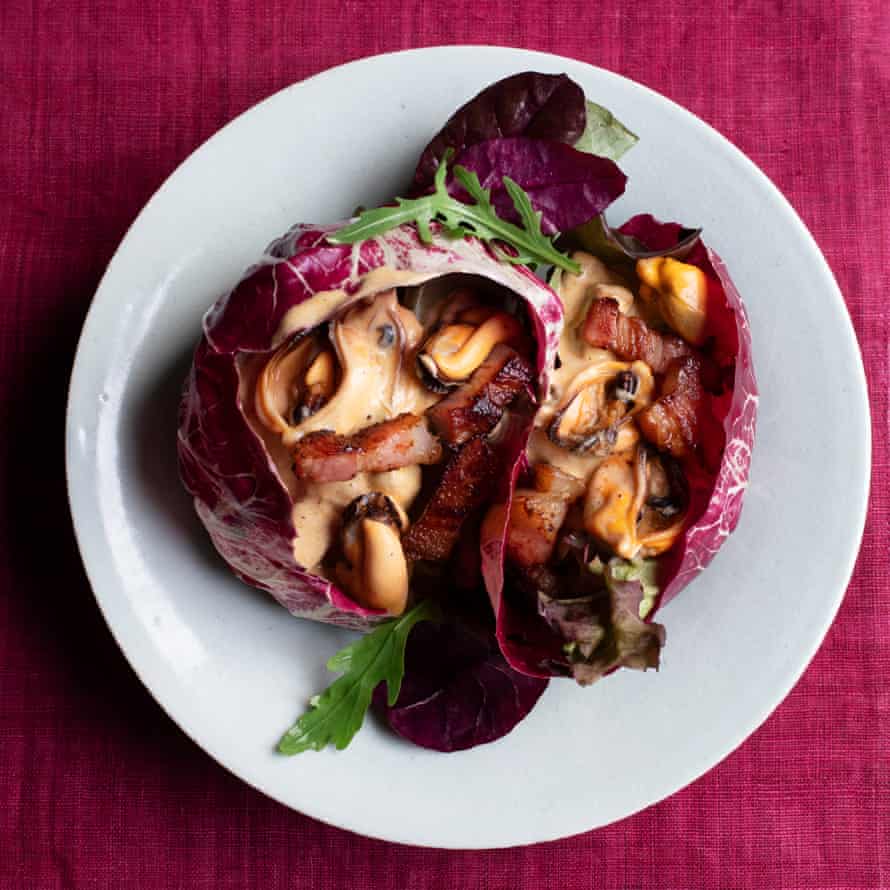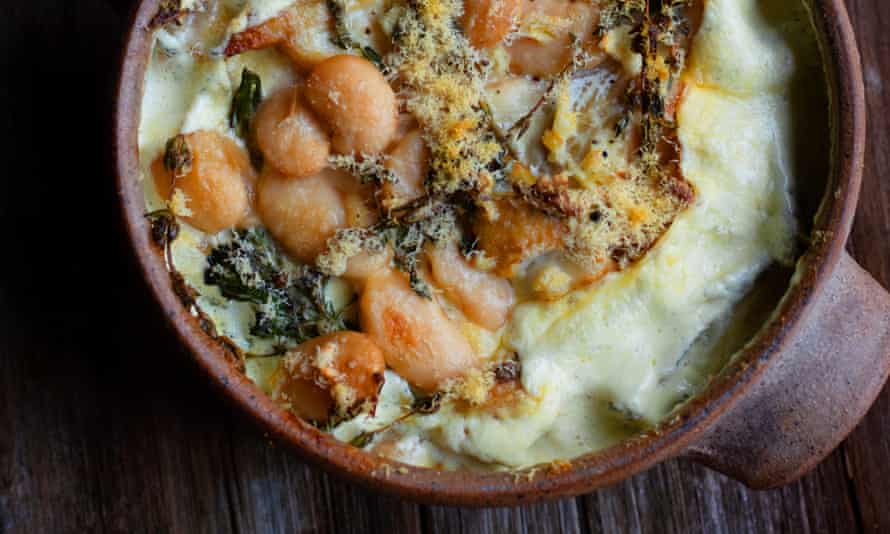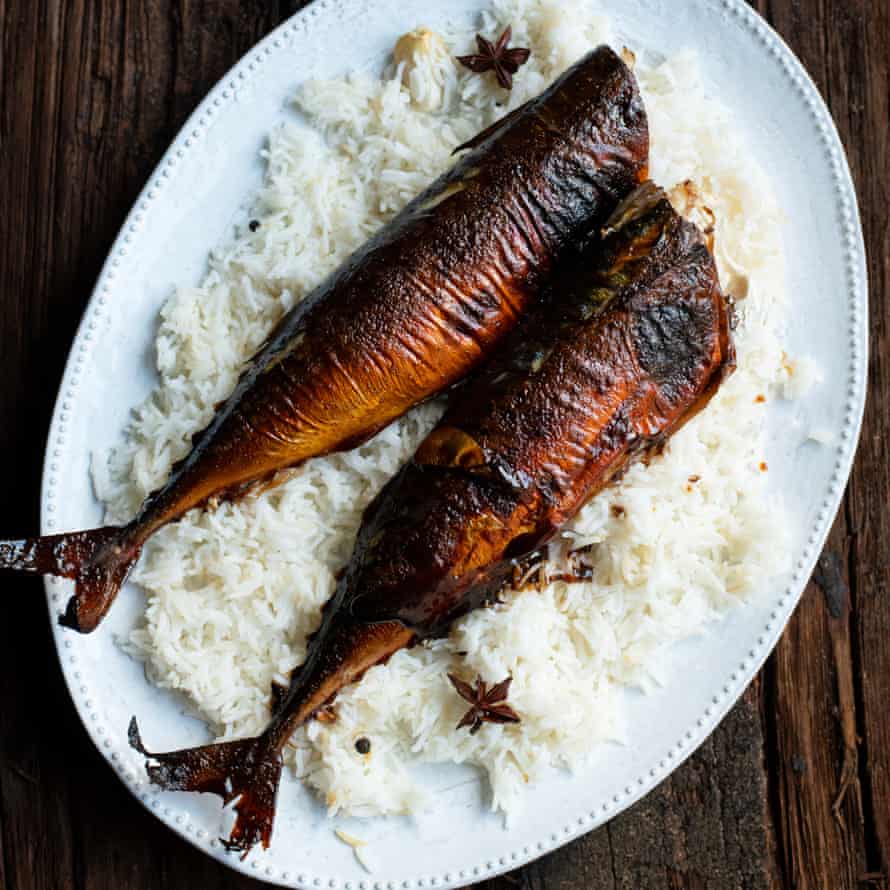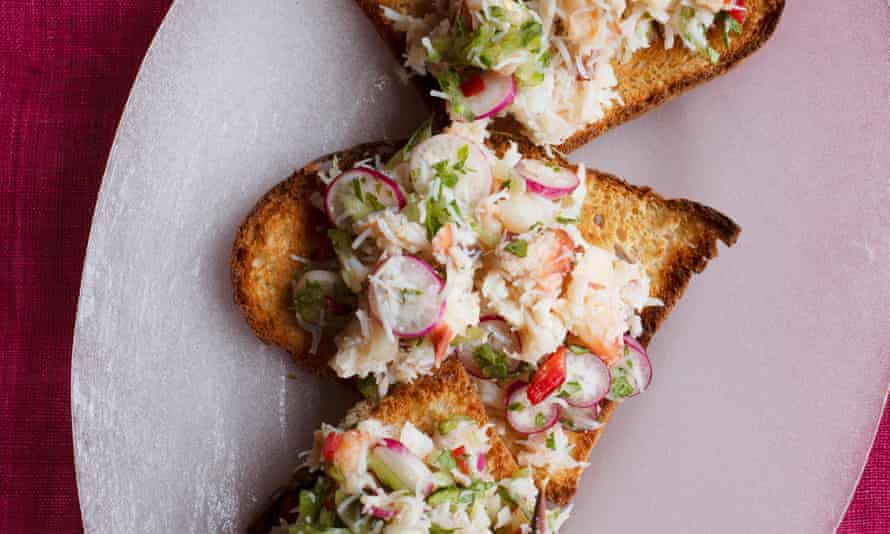Shared from www.theguardian.com
I enter the fishmongers with an open mind rather than a shopping list. There may be no smoked haddock or clams today, but there may be a pot of freshly picked white crabmeat or a soldierly row of blue and silver mackerel instead. Luckily, a ceviche of pearlescent white haddock is as fine as one made with seabass; mussels will be as good as clams in most dishes, and few will be disappointed to find their potato-crowned pie made with smoked haddock rather than cod.
With the price of good fish what it is, I am likely to toss my crabmeat with almost the same volume of cucumber, radishes and chopped herbs, or to pad out my haddock with some soft white beans such as haricot or butter beans. The cheaper seafood – mackerel and mussels – will still be eaten with little embellishment, but even they will come with handfuls of crisp leaves or on a bed of shredded and stir-fried cabbage or steamed rice.
If I am making a version of ceviche – a recipe I love to make as much as to eat – the fish will be used with plenty of appropriate vegetables or fruit. Cucumber is a constant, as is avocado, tomato or pink grapefruit. The tartness of the latter is delightfully fresh and bright. Sometimes I bring the lightly marinated fish to the table as a jumble of cubes of fish and grapefruit segments, while on other occasions I like to slice the fish very thinly and lay it – neatly overlapping – with the fruit.
While the crab toasts and ceviche makes us yearn for spring (it is just around the corner) at the heart of this collection are two cold weather main courses. A bubbling gratin – soupy, smoky and with enough beans to bolster us against the chilliest of days – and aniseed-scented baked mackerel for eating with steamed rice.
Ceviche with pickled cucumber and grapefruit
The fish rubs shoulders with sharp grapefruit, salty pickled cucumber and crisp radishes in this version of ceviche. Tiny chillies bring heat and the whole effect is dazzling.
Serves 4
red onion 1 medium
lime juice 80ml, freshly squeezed
skinless haddock 400g, from sustainable sources
red chillies 2 small, or 1 large
pink grapefruit 1
mint 20 leaves
coriander 20 leaves
extra virgin olive oil 4 tbsp
For the pickled cucumber
small cucumber 200g
white wine vinegar 5 tbsp
caster sugar 3 tsp
sea salt 1 tsp
First, make the pickled cucumbers. Slice the cucumber into paper-thin rounds. Mix together the white wine vinegar, caster sugar and sea salt. Stir well – the sugar won’t quite dissolve but no matter – toss together the cucumber and dressing, then put into a stoppered jar and seal. Leave in the fridge for a few hours or overnight, turning from time to time to moisten those slices that are not in the pickling liquor.
Peel and finely slice the red onion, then add to the lime juice and set aside for 20 minutes. Toss the onion occasionally in the juice.
To make the ceviche, slice the fish into pieces about 5mm in thickness, then place the slices in a single layer on a large serving plate. Finely slice the red chillies and add to the fish slices. Add the onions to the fish, then pour over the lime juice and set aside in a cool place, cover and leave for 20 minutes.
Peel the grapefruit with a large, very sharp knife, cutting away not only the peel but the white pith underneath. Remove the segments of grapefruit from their membranes. Arrange the grapefruit segments, cucumber slices, mint and coriander leaves over the fish, then trickle the olive oil over the fish and serve.
Crab and cucumber toasts
Crabmeat has become expensive and somewhat elusive of late. It needs using wisely, by which I mean not lost in a sea of creamy sauce. Devilled crab aside, I like the white meat best in sandwiches with (a little) mayonnaise, cucumber, some fluffy white bread and tufts of thick-stemmed watercress. It is especially good when dressed with mint, coriander and fish sauce to bring out the sweetness of the meat. Piled on thin, curly toast – what used to be known as melba toast – the whole effect is crisp, fresh, green and vibrant.
Serves 2
cucumber 350g
firm, thick white bread 4 slices
picked white crabmeat 250g
mint 30 leaves
coriander 25 leaves
rice vinegar 1 tbsp
red chilli 1 small, hot one
fish sauce 1 tbsp
radishes 6
Peel the cucumber, slice in half, and remove and discard the seeds and core. Coarsely grate the flesh into a sieve, sprinkle lightly with salt, then place the sieve over a mixing bowl and leave to drain for 30 minutes.
Cook the bread on both sides under a hot overhead grill. Slice each piece of bread in half horizontally, then toast the cut sides. The bread will be thin, crisp and will curve slightly. Set aside.
Put the crabmeat in a mixing bowl. Squeeze the cucumber lightly to remove any excess juice then add to the crab. Finely chop the mint and coriander leaves, and add to the cucumber and crab together with the rice vinegar. Finely chop the chilli, removing the seeds if you wish, and add to the crab together with the fish sauce – you might find using a fork better than a spoon. It is less likely to compact the mixture.
Trim and finely slice the radishes, stir them into the crab and pile on to the crisp toast.
Mussels and winter leaves

Mussels and pancetta are great friends – I often shred thin slices of the latter, fry to a crisp, then scatter over mussels on the half-shell. The two can be brought together in a winter salad, the pancetta cut into lardons and fried till the fat turns golden. Their salty juices can be used to dress bitter winter leaves such as chicory and frisée. This time I have tossed the leaves with a mango and yoghurt dressing – a sort of updated (fresher, brighter tasting) coronation sauce.
Serves 2-3
mussels 500g
pancetta 125g, in one piece
salad leaves 150g
For the dressing
mild curry paste 1 tbsp
mayonnaise 75g
natural yoghurt 50g
mango chutney 2 tbsp
Scrub the mussels, tug off any “beards” and check that the shells are not broken or chipped. Gently tap any that are open and discard those that do not close. Place a medium-sized saucepan over a high heat, add the mussels and 2 tablespoons of water, then cover tightly with a lid and leave to steam for 2 or 3 minutes, until the mussels have opened. Immediately remove from the heat.
Cut the pancetta into 1cm thick strips. Cook the pancetta strips in a shallow pan over a moderate heat, until the fat is golden and translucent. If they don’t have enough natural fat, then add a little oil to the pan. Remove the pancetta from the pan and set aside.
For the dressing, mix together the curry paste, mayonnaise, yoghurt and mango chutney.
Remove the mussels from their shells.
Wash the salad leaves, dry them, then put them in a serving bowl. Trickle over the dressing, add the mussels and the pancetta. Toss together gently and serve.
Gratin of smoked haddock, purple sprouting broccoli and beans

No collection of fish recipes would be complete without a dish of unalloyed comfort – a pie, pudding or gratin. Smoked haddock is something my gran and my mother cooked in milk, often using the smoky cooking liquid in an accompanying sauce. No fish is happier with cream or milk, and it is a winner in any fish pie. This week I cooked it in the form of a gratin with fat, slippery buttery beans. A handful of greens turned up in there, too.
Serves 4
purple sprouting broccoli 250g, or other long-stemmed variety
smoked haddock 650g
butter beans 2 x 400g tins
garlic 2 cloves
double cream 500ml
thyme 6 bushy sprigs
black peppercorns 6
parmesan 2 tbsp, grated
Put a medium-sized pan of water on to boil. Trim the broccoli, cut the stems in half and cook in the boiling water for 2 minutes – no longer. Remove and plunge the broccoli into a bowl of iced water.
Set the oven at 160C fan/gas mark 4. Remove the skin from the smoked haddock, then cut the fish into finger-thin pieces. Open the beans and drain away the liquid.
Peel and thinly slice the garlic. Put the cream in a saucepan, add the thyme sprigs, the peppercorns and the sliced garlic, then bring to the boil, taking care to swiftly remove from the heat as it comes to the boil. Let it sit for 10 minutes.
In a deep baking dish, place the smoked haddock, drained broccoli and butter beans, then pour over the warm, fragrant cream. Scatter the parmesan over the surface and bake for 45 minutes till lightly coloured on top.
Offer spoons and/or thick slices of crusty bread for the smoky, garlicky cream.
Roast mackerel with hoisin sauce

Mackerel’s oily flesh can take strong flavours possibly better than any other fish. I have taken to roasting it with a marinade of dark and treacly hoisin sauce, five-spice powder and honey. You need to keep an eye on it as it roasts, ideally letting the skin of the fish darken and blister. To go with this, a tangle of pickled red cabbage, a crisp winter tomato salad with a sharp dressing of rice wine vinegar or a bowl of soft, dark spinach leaves, steamed and tossed with a mere dash of toasted sesame oil. The sauce is intensely flavoured; stir it together with the rice as you eat.
Serves 2
hoisin sauce 100ml
rice wine 100ml
light soy sauce 100ml
honey 4 tbsp
five-spice powder ½ tsp
mackerel 4 medium to large, cleaned, heads removed
basmati rice 300g
sea salt ½ tsp
black peppercorns 8
pickled red cabbage to serve
Mix together the hoisin sauce, rice wine, soy sauce and honey, then stir in the five-spice powder.
Put the marinade mixture into a roasting tin, add the fish, turn them once or twice to coat and set aside in a cool place for an hour. (An occasional turn in the marinade is a good thing.)
Preheat the oven to 180C fan/gas mark 6. Turn the fish once more in its marinade, then bake for about 40 minutes. Keep an eye on the marinade and spoon some over the fish during cooking.
While the mackerel is cooking, cook the rice: wash it three times in a bowl of warm water, swishing the grains around in the water with your fingers. As you repeat the process, the water will gradually become clearer. Transfer the rice to a small saucepan to which you have a tightly fitting lid. Add the salt and 8 black peppercorns, then cover with water to come 2cm above the rice (it should be about 600ml) . Bring to the boil, lower the heat considerably and cover tightly with a lid. Leave to simmer for 10 minutes, then remove from the heat, leaving the lid in place, and set aside for a further 10. Serve the rice with the mackerel with the rice and, if you wish, somesome pickled red cabbage.
The Observer aims to publish recipes for sustainable fish. Check ratings in your region: UK; Australia; US
Images and Article from www.theguardian.com

